Haven’t we had a frustrating winter? Up north we’ve had snow on the hills followed by sudden thaws, torrential rain and the odd force 10 thrown in for good measure. For the river angler changeable conditions like this are bad news and, as usual, the worst conditions always seem to fall on the weekend.
Because of the conditions nearly all my fishing so far has been trotting for grayling or barbel fishing on the tidal Trent, but for me proper fishing in winter is chub fishing and for a while last week I dared to hope that I would catch conditions just right.
All week I pored over the Met Office five day forecast and the Environment Agency river levels site. The Yorkshire rivers are spate rivers, so the trick is not to be satisfied with just a local forecast, but to look at forecasts for towns west of the Pennines and for towns near the upper reaches of the rivers. These forecasts, together with the river levels at all the recording stations above where I’m intending fish, allow me to build up a picture of what the likely state of my chosen river will be.
By Thursday things were looking good: the river was at a decent level from where it joined the Ouse all the way to the highest recording station. The heavy showers over Thursday and Friday caused some minor worries, but the river levels stayed quiet. The last recording on Friday showed a slight upward lift, but not enough to cause me great concern.
Saturday morning on the banks of the Swale and all looks well. The forecast gales have arrived, but I’m fishing the west bank so I’ll have some shelter from the wind. The river is about a foot up and carrying a tinge of colour, which allows me to see a couple of feet under the surface – just right. I walk upstream from the car park with the intention of fishing back down to the car following a trail of mashed bread.
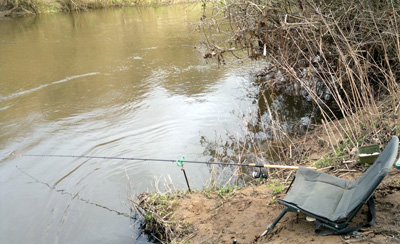 The top few swims are too exposed to the gale, so I drop into the first sheltered swim, a favourite of mine which has produced some good fish in the past. The swim is on the inside of a slight bend and has a narrow band of steadier water leading down to an alder which has partially collapsed into the river. A hawthorn bush guards the alder so you have to be content with drawing fish upstream, not a bad thing really as it allows them to drop back downstream if disturbed.
The top few swims are too exposed to the gale, so I drop into the first sheltered swim, a favourite of mine which has produced some good fish in the past. The swim is on the inside of a slight bend and has a narrow band of steadier water leading down to an alder which has partially collapsed into the river. A hawthorn bush guards the alder so you have to be content with drawing fish upstream, not a bad thing really as it allows them to drop back downstream if disturbed.
The river is pushing through so I fit the heaviest tip, a 4oz glass one, to my rod. I clip on a half ounce flattened lead and mould a lump of blue cheese around my hook and swing it out to the crease. When fishing with mash and flake on the bomb or feeder I always drop a bait into the swim before I feed. It’s difficult to predict exactly where the mash will land and I don’t want fish following it downstream before I have a chance to catch them.
Whilst I’m mixing the mash I catch a flicker of movement out of the corner of my eye and I grab the rod as the tip pulls smoothly round. I love the fight of a good chub, the dogged resistance, the head shaking and always the worry about the sudden dash for a snag! The fish gives a good account of itself and it’s a while before I slip the net under a long, lean chub of about 4lb 8oz. I don’t return the fish, but leave it in my landing net and swing another piece of cheese out to the crease.
I’ve got time to finish mixing my mash and settle back into my seat before I get another good pull – which I miss. I move my ledger stop up the line to increase the length of my tail to around 3ft in an effort to get a more confident bite, but I’m rewarded with a couple of gentle pulls which lead to nothing. Time for a change!
I swap the bomb for a small cage feeder, squeeze a lump of flake on to the hook, fill the feeder with mash and cast again. As I settle back into my chair I notice that my water line marker has disappeared beneath the surface, which means that the river has risen nearly 6 inches over the past hour. It hasn’t coloured up too much yet so I stick with the flake and mash.
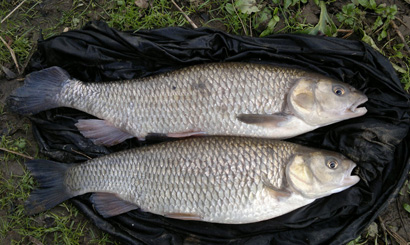 On my second cast with the flake I get a really slow pull round which at first I think is rubbish on the line, but I see a slight judder on the tip that suggests it might be a fish and I pull into another good chub. This one is a short, plump fish in fine fettle which looks to be just over 4lb.
On my second cast with the flake I get a really slow pull round which at first I think is rubbish on the line, but I see a slight judder on the tip that suggests it might be a fish and I pull into another good chub. This one is a short, plump fish in fine fettle which looks to be just over 4lb.
Given that I’ve got a chance of a few more fish out of this swim I pop both fish into a carp sack which I place in the slack water at my feet. The river is now rising rapidly and starting to colour up. I get a couple more shy bites over the next hour, but nothing positive and with the river now a couple of feet up from where it was when I started and getting very murky I decide it’s time for a move. I take a quick snap of my two chub before returning them.
It’s also time for a change of tactics. In good conditions I’d follow a trail of mash downstream, not bothering particularly to fish to obvious features, and expect to catch chub from almost anywhere as they home in on the trail of bread. In coloured water this isn’t the case: I’ll expect the chub to be in steadier paced water and for them not to move too far to take my bait. Let’s have a look at my tactics in the next swim downstream.
This swim is on a featureless straight, but it does have a crease down the near side which is formed by the alder at the bottom of my first swim. Before I start to fish I have a couple of casts to gauge the strength of the current. I’m looking to fish in water which pulls the 4oz tip on my rod around a couple of inches – in my experience this is the perfect pace for chub in these conditions. This nicely paced water is just inside the crease where the water smooths out. I add a glug of The Source to my mash and feed a couple of small balls at the head of the swim. This isn’t strictly necessary in these conditions, but I like to think that the savoury mash will whet the appetite of any chub lurking downstream.
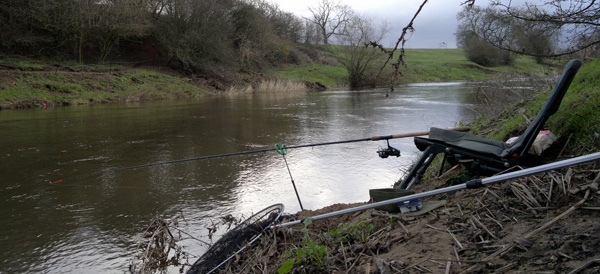
The plan now is to fish the blue cheese, starting at the top of the swim and moving down the inside of the crease, exploring the whole length of the swim. I swing the bait out and give it 15 minutes before striking the cheese off and recasting about six feet further down the swim. I repeat this process until on the fourth cast I get a good confident bite and lift into another 4lb fish. I give the swim another hour without any further indications so I decide to move again. By now the river has risen another foot and is around 3 feet above normal level. I know there are a couple of anglers downstream of me so I decide to move back up to my first swim and fish it until dark.
By now the river is really pushing through and is heavily coloured. There is still a narrow band of steadier water close to the bank, but it’s underneath the hawthorn which extends a fair way out from the bank. My only option is to cast into the current, keeping the line as close to the branches of the hawthorn as possible and let the lead swing back towards the bank on a tight line. Again, a lump of cheese is the bait and I rely on the smell of the cheese and the fact that there was bait in the swim earlier in the day to attract the fish.
I re-cast every 20 minutes or so, striking off the cheese before retrieving and on my third cast, just as it’s getting dark the rod tip pulls round a few inches and holds. I’m not sure if it’s rubbish on the line or a fish so I hold the rod and wait. A few seconds later the tip nods gently and I lift into another decent chub, probably the smallest of the day.
I debate having another cast, but darkness, the swirling wind and the need to cast close to the hawthorn convince me that enough is enough and I call it a day. Four decent chub has been a good result considering the conditions – proper fishing!
Some Thoughts on Chub Fishing in a Rising River
Fish Location
A rising river in winter doesn’t offer the best prospects for catching chub, but as with all fishing the key to catching is locating the fish and a little understanding of chub behaviour pays dividends here.
The three main factors which govern chub behaviour, and thus location, are: water temperature, water clarity and the pace of the water. At this time of year chub generally follow the simple rule of the lower the temperature the slower the water and have moved into steadier, deeper water. Where exactly they are in that slower water depends on the water’s clarity and pace.
In clear water, especially in bright conditions, chub won’t be too far from cover, but as the light fades they will move out into the river to feed. As the water colours up the fish will happily move away from cover to feed and so with a tinge of colour in the river chub will often be found out in the river far from cover. As the water colours up further the chub seem less keen to feed and don’t seem to be willing to move too far for food. I suspect that this has more to do with increased vulnerability to predators rather than a reduction in appetite.
The final factor is the pace of the water. My rule of thumb for winter chub is that if the water is too fast for me to use my 4oz quiver tip then it’s too fast for the chub. In full on floods when I’d have to use my barbel rods then I won’t bother fishing for chub.
So let’s look at what happens when the river starts to rise and how I change my tactics.
Before the flood arrives the river is cold and clear. I fish for chub close to cover and normally use a quiver tip, but I’m quite happy to use the float if the fancy takes me. As the river starts to rise and colour up I will normally use the float as my first line of attack, only using the quiver tip if the conditions don’t favour the float. In these conditions I don’t worry too much about fishing close to cover and will happily fish out in the river.
As the river continues to rise the pace of the current increases and the river colours up still further. I will now switch back to the quiver tip and let the pace of the water dictate the line I fish, but I’ll assume that fish will move up to take my bait. Once we get into proper flood conditions and visibility drops to below about a foot I will then assume that the chub won’t move far to take a bait and I will actively search them out, by exploring the full length of a crease and fishing small slack areas on the edge of the main current.
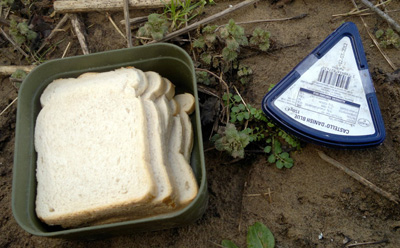 Bait
Bait
If you’d asked me a few years ago I’d have said my first line baits were bread, maggots and luncheon meat. Nowadays I’ve replaced luncheon meat with cheese, not because it’s a better bait, but because I feel that the chub in the rivers I fish are wary of luncheon meat. I will occasionally add micro pellets to my mash, but it’s not my standard approach.
The art of making mash… I’m constantly refining my ideas on mashed bread and my current thinking is that in-store made sliced bread is the best off the shelf solution. These loaves are slightly drier in texture than ‘bought-in’ sliced bread and they make perfect mash straight from the bag. I make my mash on the bank by placing about six slices of bread in a bait box, covering them with water and leaving it for a few minutes. I then squeeze it hard against the side of the bait box until no more water runs out.
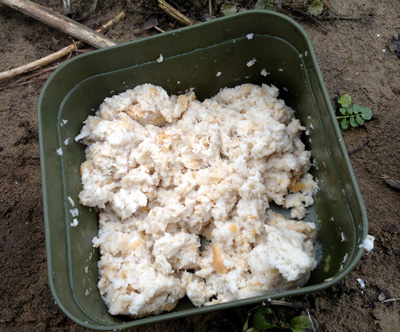 When scrunched up the mash should be a nice fluffy consistency which will hold in a ball when squeezed. If it won’t hold in a ball it’s too wet, if the ball doesn’t start to break up as it hits the surface then the mash is too dry or you need to change your loaf or use it stale. I nearly always flavour my mash using either Nash Cheesey Chops (getting hard to find) or The Source. I do this because in my opinion mash fulfils two functions, firstly it’s a visual attractor which chub will home on to in clear water and secondly it’s a flavour carrier. In a rising river I use small amounts of highly flavoured mash in a cage feeder – it’s a flavour carrier.
When scrunched up the mash should be a nice fluffy consistency which will hold in a ball when squeezed. If it won’t hold in a ball it’s too wet, if the ball doesn’t start to break up as it hits the surface then the mash is too dry or you need to change your loaf or use it stale. I nearly always flavour my mash using either Nash Cheesey Chops (getting hard to find) or The Source. I do this because in my opinion mash fulfils two functions, firstly it’s a visual attractor which chub will home on to in clear water and secondly it’s a flavour carrier. In a rising river I use small amounts of highly flavoured mash in a cage feeder – it’s a flavour carrier.
I use a good quality blue cheese for my chubbing (Castello from my local Asda) which is soft enough to use on the hook straight from the packet. If I’m using cheese I will sometimes use it in conjunction with cheese flavoured mash in a small feeder, but normally I will fish it as a single bait on the bomb, striking off before I re-cast to get a few samples in the swim. A strongly flavoured cheese will draw fish from a long way downstream and is as good a bait as any in coloured water. I fish cheese on a size 10 or 8 hook, moulding it around the shank and keeping the point clear of the bait.
Flake is, in my opinion, a much under-rated bait. OK, it’s regarded as one of the best baits for chub in clear water, but it works almost as well in coloured water – it is after all highly visible and it does have a smell. If the water is colouring up and I already have some mash in my swim then I will continue to use flake with every confidence. I normally use a size 10 or 8 hook for fishing flake and will often use a really big piece on these hooks.
Here’s a tip for those frustrating times when chub are giving good pulls, but you can’t hit them: pinch a tiny piece of flake around the eye or the spade of your hook. This looks ridiculous, but it’s amazing how often it fools a wary chub. They find it almost impossible to pick the bait up without pricking themselves.
A Word on Tackle
I use a quiver tip rod for all my static chub fishing. There is a place for the bolt rig, but most of my fishing is in fairly prolific rivers so I don’t need to use it. I’ve learned over the years that purpose designed quiver tip rods are always better than twin tip Avons for chub. Twin tip Avon rods are always a compromise and I’ve not found one where the blend of the quiver tip into the carrier section is as smooth as purpose-designed quiver tip rods.
My current choice of rod may surprise you – it’s a Drennan Puddlechucker method feeder. I think Drennan are doing themselves a disservice with this rod as it’s one of the best chub rods I’ve come across. It comes with 2oz, 3oz and 4oz slow taper glass tips, it’s just right for 8lb line and it has enough power in the butt to cope with the occasional accidental barbel.
For chub fishing I always use a low diameter, copolymer main line which allows me to fish with lighter leads and feeders than conventional nylon lines. I’ve been using the Fox Rage Reflex line which, although designed for lure fishing, makes a great chub fishing line. It’s got low diameter, low stretch and good knot strength and is nice and clear. Other lines to look at are WB Clarke Matchline and Maver Jurassic, both of which I’ve used regularly and found to be reliable.
This season I’m trying a new hook length line that is looking very promising. It was recommended to me by Graham Marsden and it’s an Italian pole line called Sagitar Dip (supplied by Italia Fishing on Ebay) which has very low diameter for its strength and really good, reliable knot strength. The 7lb breaking strain is perfect for chub fishing.
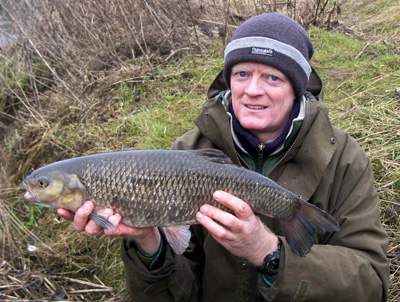 Conclusion
Conclusion
Well that was a long one! This article grew a bit in the writing due to questions from a couple of friends of mine. The first was from Adam Perkin, who fished with me on trip described above, which was about how to fish a rapidly rising river and what baits to use. The second was from John Conway and it was about my opinion on the best river levels for chub fishing.
My answer to Adam was that it’s all about location and that baits are a secondary consideration. I haven’t answered John yet, but the more I think about his question the more I think it can’t be answered, or at least it can’t be answered in a simple straightforward way.
The answer lies in the pace of the current, the clarity of the water and, a little, on the temperature. The first two factors are related to the river level, but they will vary from river to river and over the length of the river.
The ideas expressed above are based on over 30 years of fishing for chub. They are however only opinions, conclusions drawn from my own experience, coloured with my preferences and prejudices. I don’t expect everyone to agree with them, but they work for me.
Tight lines!










